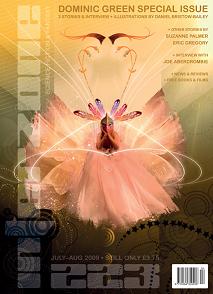 “Butterfly Bomb” by Dominic Green
“Butterfly Bomb” by Dominic Green
“Coat of Many Colours” by Dominic Green
“Glister” by Dominic Green
“The Transmigration of Aishwarya Desai” by Eric Gregory
“Silences and Roses” by Suzanne Palmer
Reviewed by Nader Elhefnawy
The August 2009 Interzone is devoted to author Dominic Green. Like many successful short fiction writers who have not crossed over into publishing novels (a situation that has led him to make some of his manuscripts available on his web site), Green enjoys only limited name recognition. However, he is also a longtime Interzone regular, contributing twenty stories to the magazine in the last thirteen years, appearing in, among others, the March and May/June 2003 issues, and the May 2005 issue, which carried the magazine reader’s favorite for the year (and subsequent Hugo nominee) “The Clockwork Atom Bomb” (freely available here ).
In keeping with the theme, Green penned three of the five stories carried in this issue, and is also the subject of an interview by Andrew Hedgecock (well worth a look).
The issue’s (and Green’s) first story is “Butterfly Bomb,” about the relationship of an elderly space settler known to us as “Old Krishna” to an artificial life form with which he shares his home, which is suddenly complicated by the arrival of a slaver ship into their lives. The emotional side of the relationship is in some respects thinly sketched (in part because its nature is so closely tied to some of the bigger surprises at the tale’s end), but it is adequate to serve as a basis for an entertaining and even touching adventure filled with interesting bits. (I particularly liked the scene in which Old Krishna had to cope with an epistemological debate that breaks out between different artificial intelligences inside a starship’s system, paralyzing the vessel.) “Butterfly Bomb” also makes for a good introduction to themes prominent in his work, not the least of them biotechnology, ecology, and colonization, as well as his penchant for old-fashioned space opera (he cites Jack Vance as an influence) that is unmarred by his awareness of the problems surrounding key tropes like faster-than-light drives and the aliens who led Enrico Fermi to wonder aloud “Where are they?”
Green’s second piece, “Coat of Many Colours,” is set in a near-future Brazil where the Amazon has become a near-desert, and its food situation desperate. While touching on assorted aspects of this milieu, this is less the basis for an exploration of a post-cyberpunk version of the developing world (a fairly popular theme these days) than a backdrop to a debate on animal intelligence, the stakes of which have been raised (and the terms of which have been complicated) considerably by biotechnology and economics–in this instance, one Dr. Mullen brought to the country to test the intelligence of a new experimental animal, determining the parameters within which it can be exploited. While it is talky compared with the story preceding it (and the one following it as well), and its final twist isn’t all that I hoped for, the world-building is skillful and bleakly atmospheric, and the handling of the essential question is an intelligent and engaging one.
In Green’s third and last piece, “Glister,” Alasdair McQuarrie, a Scotsman who (like many a space opera hero before him) has bought a starship to make his fortune out in space, learns of a planet named Midas, the ecology of which cycles gold the same way that Earth’s ecosystem processes carbon, and tries to strike it rich there. The action-packed, planet-hopping story that follows is the strongest piece of Green’s in the issue, offering his richest world-building, his tightest and most satisfying narrative arc, and his most sophisticated treatment of the themes mentioned above.
The two other stories in this issue are Eric Gregory‘s “The Transmigration of Aishwarya Desai,” and “Silence & Roses” by Suzanne Palmer.
In Gregory’s story, the titular character, Dr. Aishwarya Desai, is a controversial anthropologist brought out to the frozen extrasolar world of Ganesha to debate a Big Name in her field about her claim to have made psychic contact with “the only other beings we’ve encountered in our multi-verse.” The title also gives more than a clue to the story’s trajectory, but the tale emphasizes the process–and in particular, that experience of contact with that “other.” A bit choppy in its second half, it is a bit harder to follow than the other stories here (though still easier than a good many pieces I’ve seen in Interzone‘s pages before), and its style is not inappropriate with the kind of story it ably tells.
Finally, in Palmer’s “Silence & Roses,” Button-4-Circle-Peach is one of a number of robot caretakers on an estate established by wealthy returnees to their home planet following a war that left their planet a barbaric wasteland (in which that estate is perhaps the only island of comfort and order). The tale begins with the “falling silent” of the last human resident, Thomas. On the same day, a young girl arrives from outside the city. The two events throw the robots into confusion, but also point Button-4 toward a new purpose.
Many of the elements of “Silence” are quite familiar to those who have read much post-apocalyptic fiction of the kind Walter Miller gathered together in his recently reprinted Beyond Armageddon anthology, but Palmer’s sensitive and capable treatment of the story makes it well worth the read.